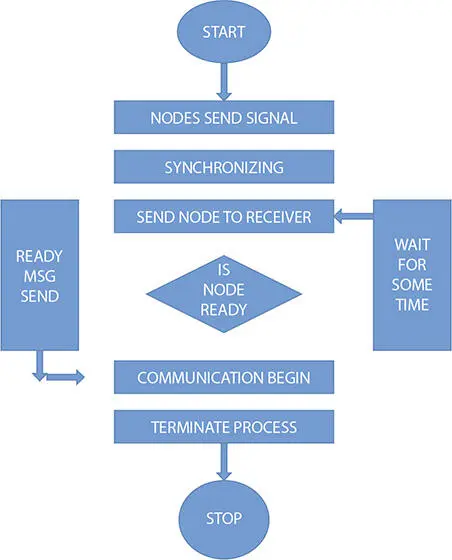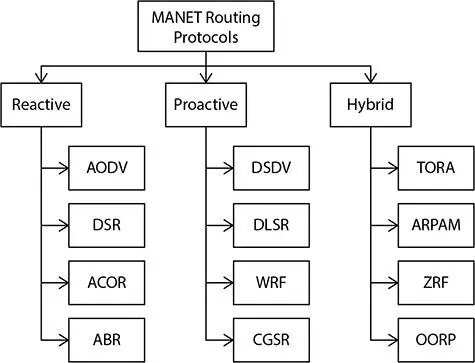WSN is commonly used communication network. It is self-organized, structure-less wireless network to observe the surroundings and environmental changes. It consists of free nodes in wireless sensor network. One of the node acts as source and other acts as destination. We use base station or sink as an interface between the system and users. It consists of sensing and computing device, radio transceivers, and power component. It has limited computing speed, storage capacity, and communication bandwidth.

Figure 6.1 Transmission process.
It is known as mobile adhoc network which contains nodes that automatically configure the network. MANET [1–4] is network which communicates with no dependence on preexisting infrastructure. In topology for MANET, nodes are not fixed. It is of low cost, flexible in nature, and user friendly. The production cost of magnet is very low. Network topology is slow. The mobility factor in magnet is low. While considering node density, it is sparse in nature. There are many nodes in the mantes. The node power depends on the power. Nodes in the mantes move randomly in the network.
It is a challenging class of MANETs, VANET [1–4] is unlike MANET in its architecture where it may combine between WLAN and adhoc network. We can say it is the formation of a wireless network for data transfer within the vehicles. A VANET replaces vehicles just as in MANET to form a mobile network. In VANET, a node transmit data packet within range of 100 to 300 meters. If signal of one node drops, then other cars can use the information to connect vehicles to one another. The connection is in between vehicles and from vehicle to roadside router system or to the center node of VANETs. By allowing this system, we can maintain or develop a mobile network. Short-range radios are the basic part of the system that is installed in the vehicle. VANET comprises of different routing protocols.
FANETs is created within the UAVs (unmanned air vehicle). Mobility degree of FANETs [1–4] is very high as compared to the MANETs and VANETs. In FANETs, we use nodes that are in flight. In FANETs, various sensors are installed and every sensor has different data transfer schemes. They all consist of a peer-to-peer, self-forming, and self-healing network, and there is fast change in topology. Due to the high mobility factor, FANETs topology changes more frequently as compare to the other networks.
6.2.6 Overview of Routing Protocols
6.2.6.1 MANET
6.2.6.1.1 Proactive
Proactive protocol stores the information of routing and constantly updates the information by changing the control packet in their neighbors. Link-state routing algorithms are used in which uses link information from their near nodes frequently. DSDV, OLSR, and WRP are examples of proactive routing protocol as shown in Figure 6.2and a comprehensive comparative analysis is presented in Table 6.1.

Figure 6.2 MANETs routing protocol.
Table 6.1 Comparison of proactive reactive and hybrid protocol.
| Features |
Reactive |
Proactive |
Hybrid |
| Mobility |
Route maintenance |
Periodic update |
Combination of both |
| Storage requirement |
Low |
High |
Medium |
| Bandwidth requirement |
Low |
High |
Medium |
| Power requirement |
Low |
High |
Medium |
| Stability |
Not suitable for large networks |
Low |
Suitable for high networks |
| Latency |
High due to flooding |
Low due to routing table |
Low outside the range |
| Route information |
Available when required |
Always available |
Combination of both |
| Route structure |
Flat |
Both flat and hierarchical |
Hierarchical |
| Route overhead |
Low |
High |
Medium |
6.2.6.1.1.1 Destination Sequenced Distance Vector Routing Protocol (DSDV)
It is a table-driven routing protocol. It actually extends distance vector route protocol of the wired networks. It is based on the Bellman-ford routing algorithm. For count-to-infinity problem Distance vector routing protocol was not suited for MANETs. Destination Sequenced Distance Vector Routing Protocol (DSDV) [8–12] discovered as a solution.
Destination sequence number is stored along with nodes in the routing table maintained by each node. If entry consists of new updated route to destination with sequence number, a node will include the new update in the table.
6.2.6.1.1.2 Global State Routing (GSR)
GSR is pre-table routing protocol. It actually extends link state routing of the wired networks. It is based on the Dijkstra’s routing algorithm. LSRP was not suited for mobile adhoc networks because in it, each node uses the link routing data directly into the whole network. Global flooding which may lead to the congestion of data packets in the network.
To solve this issue, Global State Routing Protocol (GSR) [8–12] discovered as a solution. Global state routing does not flood the link state routing packets globally into the network. In GSR, each of the mobile nodes contains tables and lists.
Reactive routing protocols decrease node as an overhead present in proactive protocols. During routing, discovery process to maintain the table usually distance vector algorithm is used. In MANET, DSR, AODV, TORA, and LMR are reactive protocols.
6.2.6.1.2.1 Dynamic Source Routing Protocol (DSR)
It is an on demand routing protocol. In DSR, the route always discovered upon request. Route finding procedure is used by immersing the route request packets in the mobile network.
It consists of two phases [8–12]. This phase calculates the shortest path for transfer of information between sender and receiver. This phase performs the maintenance work of the route as the path in the MANETs. Nature of nodes is dynamic and many cases of link breakage resulting in the network failure between the mobile nodes.
6.2.6.1.2.2 AdHoc On-Demand Vector Routing Protocol (AODV)
It is DSR with few changes. First of all route discovery is happened then after the data discovery path is stored in header and then transmission happen. Size of network increases, and due to which, header size increases which causes the complication [1–4].
AODV protocol is discovered in the form of solution. Main difference is in the way of storing the path; AODV stores the path of routing table, whereas DSR stores it in the data packet’s header itself. It also operates in two steps: discovery of route and maintenance of route.
6.2.6.1.3 Hybrid Routing Protocol
Reactive and pro-active routing protocols combine to make a hybrid protocol. These protocols are adaptive in nature and adapt according to the zone and location of the source and sink nodes. ZRP is one of the best example this phenomenon.
6.2.6.1.3.1 Zone Routing Protocol (ZRP)
Читать дальше














